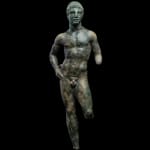Hellenistic
Further images
Provenance
Private collection, Austria, acquired in the 1990sGorny and Mosch, Munich, 14 December 2007, lot 14
Private collection, acquired from the above
Literature
The Seleucid Empire was founded by the Macedonian general Seleucus I Nicator, following the division of the Macedonian Empire after the death of Alexander the Great in 323 BC. The Seleucid Empire was one of the major powers of the Hellenistic world alongside the Ptolemaic and Antigonid Empires. Antiochus VII Euergetes, nicknamed Sidetes after the city of Side in Asia Minor where he grew up (Pamphylian coast of modern Turkey), ruled the Hellenistic Seleucid Empire from 138 – 129 BC. He was the last significant Seleucid ruler, and following his death, the empire declined until it was conquered by Rome 63 BC.
The wide diadem is a distinctive feature of the Seleucid ruling dynasty. The highly individual physignomy of the detailed and well-modelled head, in particular the prominent hooked nose and the curling lip, are reminiscent of portraits of Antiochus VII (circa 138 - 129 BC). The Hellenistic ruler cult often sees rulers portraying themselves as gods and athletes, drawing on Classical prototypes to convey their god-like perfection and omnipotence.
It is likely that this bronze originally showed the king as Herakles, and the lion-skin would have hung over his now missing left forearm. There is a Roman bronze in the Nelson Atkins, Kansas City, depicting Antiochus IV Epiphanes as Herakles (acc.no. 46-37) where he stands in the same posture. The iconography is meant to refer to Alexander the Great, who claimed to be descended on his father’s side from Herakles. See A. Kozloff, D. Mitten, The Gods Delight: The Human Figure in Classical Bronze, Cleveland, 1988, 175. The majestic pose and stance in both this Kallos bronze, and the Nelson Atkins example indicates that both are likely based on a now lost large-scale prototype chosen by the Seleucids to convey their visual language of authority, power, and legitimacy.







